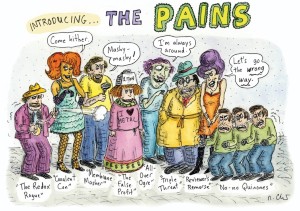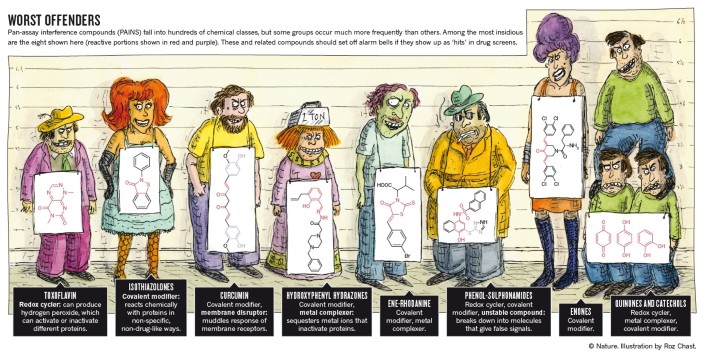Molecules and Compunds Foiled Again Post Lab
Naivety virtually promiscuous, assay-duping molecules is polluting the literature and wasting resources, warn Jonathan Baell and Michael A. Walters.

Credit: Illustration by Roz Chast
Academic researchers, drawn into drug discovery without advisable guidance, are doing muddled scientific discipline. When biologists identify a poly peptide that contributes to illness, they hunt for chemical compounds that bind to the poly peptide and affect its activity. A typical assay screens many thousands of chemicals. 'Hits' become tools for studying the disease, besides as starting points in the hunt for treatments.

But many hits are artefacts — their activity does not depend on a specific, drug-like interaction betwixt molecule and protein. A truthful drug inhibits or activates a protein by fitting into a binding site on the protein. Artefacts take destructive reactivity that masquerades as drug-like binding and yields imitation signals across a variety of assays1,2.
These molecules — pan-assay interference compounds, or PAINS — have defined structures, roofing several classes of compound (run across 'Worst offenders'). But biologists and inexperienced chemists rarely recognize them. Instead, such compounds are reported as having promising activity confronting a broad variety of proteins. Time and research money are consequently wasted in attempts to optimize the action of these compounds. Chemists make multiple analogues of apparent hits hoping to improve the 'fit' between protein and compound. Meanwhile, true hits with real potential are neglected.
Until the past decade or so, screening work was mainly performed at pharmaceutical companies, and supported by experienced chemists. It is now increasingly common in academic environments, in which the aforementioned support may not exist. An instance of this tendency, the Bookish Drug Discovery Consortium, founded in 2012, already boasts more than 115 centres in 9 countries. Unfortunately, growing numbers of academic drug researchers are typically not trained to separate hits into compounds proficient, bad and uglythree.
The apparent activity of PAINS is and then seductive that piece of work continues despite published reports explaining that a chemical compound interferes with assays. One under-appreciated report4 identified half-a-dozen molecules that showed action against one-third or more of the proteins that they were screened against.
Repeated identification of the same types of molecule as promising hits against dissimilar proteins is polluting the chemical literature. Publications falsely revalidate molecules as good drug leads and feed Sisyphean cycles of 'screen, publish, flounder'. Chemical companies include these artefacts in their sales catalogues every bit published protein inhibitors, and other biologists first using them in their own studies.

Credit: Illustration past Roz Chast
Often termed 'bad actors', PAINS are really excellent actors: they impersonate promising leads only too well. One of us (J.B.) outset published a guideone to identifying PAINS in 2010, subsequently his lab spent the equivalent of two or iii employee years on futile work. The other of us (M.A.W.) became an anti-PAINS abet afterward preparing a manuscript and patent application for a potential fungicide, only to realize that many of the compounds identified equally 'actives' were not. For case, some compounds underwent non-specific chemical reactions with proteins. More than than a year was spent working out what was really going on, using assays for misreckoning backdrop such as assemblage, chemical decomposition, protein reactivity and fluorescence.
Meliorate awareness of these molecules and a few precautionary practices could, nosotros estimate, salve years of biomedical-research work and millions of dollars in wasted experiments (see 'PAINS-proof drug discovery').
Misleading mirage
In a typical academic screening library, some five–12% of compounds are PAINS1, which can exist rediscovered in multiple assays. This reflects the proportions in the pre-assembled libraries that about academic laboratories buy or access, for example the Library of Pharmacologically Active Compounds (LOPAC) from chemical-supply company Sigma-Aldrich, and the Molecular Libraries Small Molecule Repository (MLSMR) from the US National Institutes of Health.
Near PAINS function as reactive chemicals rather than discriminating drugs. They requite faux readouts in a variety of means. Some are fluorescent or strongly coloured. In certain assays, they give a positive bespeak even when no poly peptide is present. Other compounds tin trap the toxic or reactive metals used to synthesize molecules in a screening library or used as reagents in assays. These metals and so give rise to signals that take zippo to practice with a compound's interaction with a protein. Other PAINS coat a protein or sequester metal ions that are essential to a protein's function, or they may alter proteins chemically without plumbing fixtures specifically into a binding site. All of these mechanisms thwart farther attempts to improve a molecule's biological activity by tweaking its structure (the art known every bit medicinal chemistry).
PAINS oft interfere with many other proteins as well equally the 1 intended. For example, nether certain assay weather, some molecules — redox cyclers — produce hydrogen peroxidev, an antiseptic that is likewise produced by certain immune cells. The hydrogen peroxide inactivates the target poly peptide and makes the compound await like a good inhibitor. But the compound itself may not bind to the protein at all.
After a striking is identified, often the next step is to test it in cells. PAINS frequently have more than one interference mechanism. They might produce a desired cellular readout, such every bit growth inhibition, even without acting every bit expected. Researchers are besides readily convinced that a compound has potent action against a protein target. They purchase similar compounds from commercial suppliers and use expensive medicinal-chemistry resource to brand and test more analogues. Sometimes a molecule fails merely later on going through patenting and cess in animals6. It is regrettably easy, in our feel, to get a misleading readout in an animal model that is not related to the predictable mechanism of action.
In fact, existent hits — molecules that do interact specifically with the desired protein — often exercise not bear witness action in cells until structures are modified to bind more than efficiently or to enter cells more readily7.
All hurting, no gain
Some of the compounds that should ring the most alarm bells are toxoflavin and polyhydroxylated natural phytochemicals such as curcumin, EGCG (epigallocatechin gallate), genistein and resveratrol. These, their analogues and similar natural products persist in being followed up as drug leads and used as 'positive' controls even though their promiscuous actions are well-documented8,9.
Rhodanines exemplify the extent of the problem. A literature search reveals 2,132 rhodanines reported equally having biological action in 410 papers, from some 290 organizations of which only 24 are commercial companies. The academic publications generally paint rhodanines as promising for therapeutic evolution. In a rare example of good practice, one of these publicationsten (by the drug company Bristol-Myers Squibb) warns researchers that these types of compound undergo light-induced reactions that irreversibly modify proteins. It is hard to imagine how such a mechanism could be optimized to produce a drug or tool. Withal this paper is nigh never cited by publications that assume that rhodanines are behaving in a drug-like way.
Most PAINS office as reactive chemicals rather than discriminating drugs.
Very occasionally, a PAINS compound does collaborate with a protein in a specific drug-like style. If it does, its construction could be optimized through medicinal chemistry. Withal, this path is fraught — it tin be hard to distinguish when activity is caused by a drug-like machinery or something more insidious. Rhodanines also occur in some 280 patents, a sign that they have been selected for further drug evolution. Yet, to our knowledge, no rhodanine plucked out of a screening campaign is in the dispensary or even moving towards clinical evolution. We regard the effort to obtain and protect these patents (not to mention the work backside them) as a waste of money.
In a move partially implemented to assist editors and manuscript reviewers to rid the literature of PAINS (among other things), the Journal of Medicinal Chemical science encourages the inclusion of computer-readable molecular structures in the supporting information of submitted manuscripts, easing the use of automated filters to identify compounds' liabilities. We encourage other journals to do the same. We besides advise that authors who take reported PAINS as potential tool compounds follow up their original reports with studies confirming the subversive action of these molecules. Labelling these compounds conspicuously should subtract futile attempts to optimize them and discourage chemic vendors from selling them to biologists as valid tools.
Most of all, academic drug discoverers must exist more vigilant. Molecules that show the strongest activity in screening might not be the best starting points for drugs. PAINS hits should almost ever be ignored. Fifty-fifty trained medicinal chemists accept to be conscientious until they go experienced in screening. Take it from the states: do not even start down these treacherous routes.
References
-
Baell, J. B. & Holloway, G. A. J. Med. Chem. 53, 2719–2740 (2010).
-
Baell, J. B. Future Med. Chem. two, 1529–1546 (2010).
-
Dahlin, J. L. & Walters, Chiliad. A. Future Med. Chem. six, 1265–1290 (2014).
-
Hu, Y. & Bajorath, J. AAPS J. fifteen, 808–815 (2013).
-
Baell, J. B. Drug Discovery Today 16, 840–841 (2011).
-
Ramesh, C. et al. J. Med. Chem. 53, 1004–1014 (2010).
-
Baell, J. B., Ferrins, Fifty., Falk, H. & Nikolakopoulos, G. Aust. J. Chem. 66, 1483–1494 (2013).
-
Priyadarsini, Thousand. I. Curr. Pharm. Des. nineteen, 2093–2100 (2013).
-
Ingólfsson, H. I. et al. ACS Chem. Biol. ix, 1788–1798 (2014).
-
Voss, One thousand. E. et al. Bioorg. Med. Chem. Lett. 13, 533–538 (2003).
Author data
Affiliations
Corresponding authors
Related links
Rights and permissions
About this article
Cite this commodity
Baell, J., Walters, M. Chemistry: Chemical con artists foil drug discovery. Nature 513, 481–483 (2014). https://doi.org/ten.1038/513481a
-
Published:
-
Issue Engagement:
-
DOI : https://doi.org/10.1038/513481a
Farther reading
Source: https://www.nature.com/articles/513481a
0 Response to "Molecules and Compunds Foiled Again Post Lab"
Post a Comment